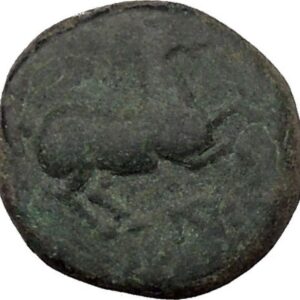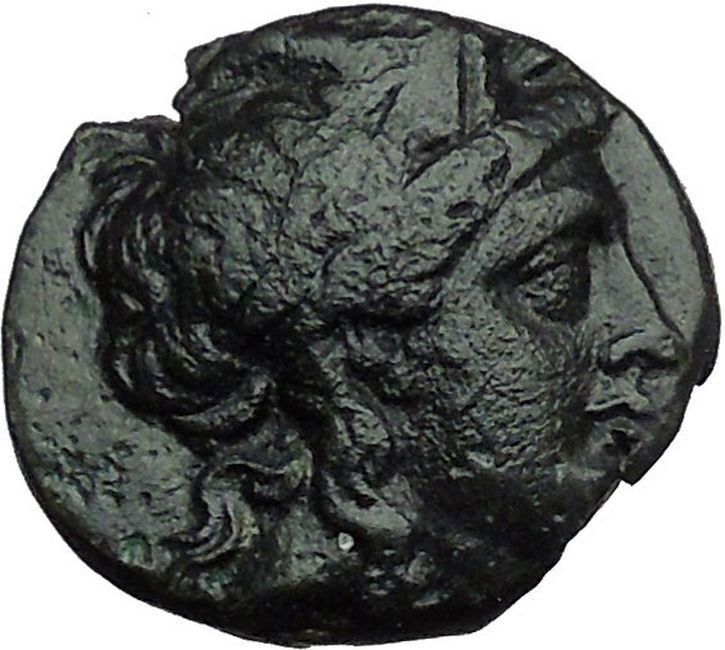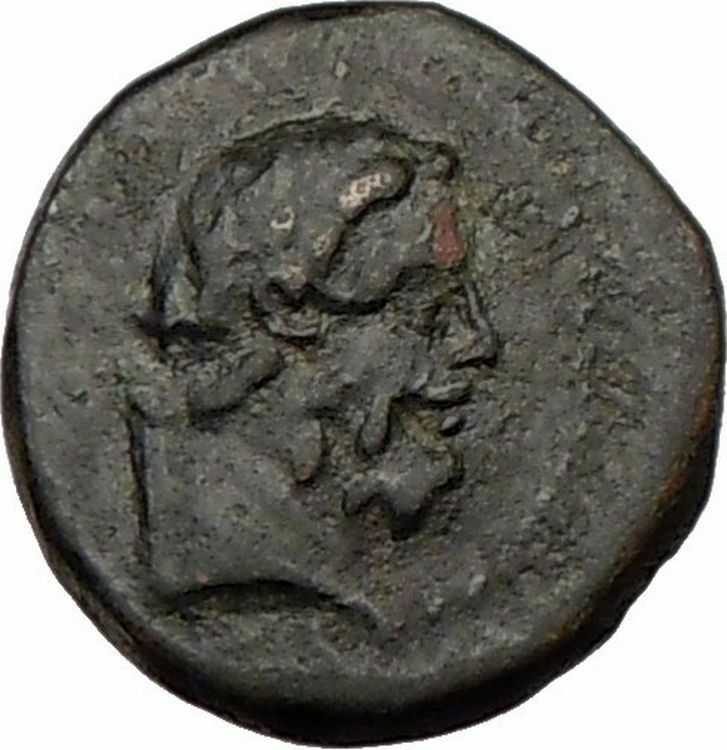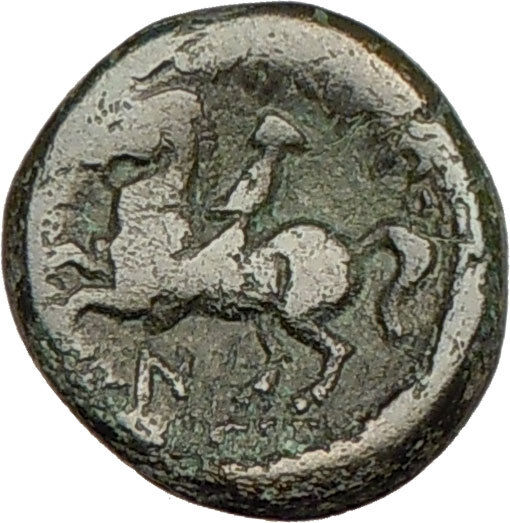|
Greek city of Skepsis in Troas
Silver 15mm (3.25 grams) Struck circa 350-310 B.C.
Reference: Sear 4136 var.
Forepart of winged horse right, body terminating in horn.
Σ – K either side of fir-tree; all within linear
square.
You are bidding on the exact item pictured,
provided with a Certificate of Authenticity and Lifetime Guarantee of
Authenticity.
The Troad or Troas is the historical name of the
Biga
peninsula (modern
Turkish: Biga Yarımadası,
Greek
: Τρωάς)
in the northwestern part of
Anatolia
,
Turkey
. This region now is part of the
Çanakkale
province
of
Turkey
. Bounded by the
Dardanelles
to the northwest, by the
Aegean Sea
to the west and separated from the
rest of Anatolia by the
massif
that forms
Mount Ida
, the Troad is drained by two main
rivers
, the
Scamander
(Karamenderes)
and the Simois
, which join at the area containing the
ruins
of
Troy. Grenikos, Kebren, Simoeis, Rhesos, Rhodios, Heptaporos and
Aisepos were seven rivers of the Troad and the names of the river gods that
inhabited each river.
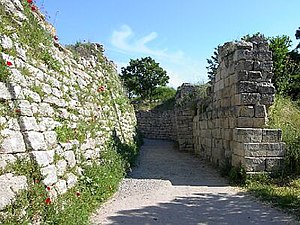
Part of the walls of Troy
History
The Troad gets its name from the
Hittites
‘ name for the region, Taruisa.
This identification was first put forth by
Emil Forrer
, but largely disputed by most
Hittite experts until 1983 when Houwink ten Cate showed that two fragments were
from the same original
cuneiform
tablet and in his discussion of the
restored letter showed that Taruisa and
Wilusa
(Troy) were correctly placed in
northwestern Anatolia. According to
Trevor Bryce
, Hittite texts indicate a number
of
Ahhiyawan
raids on Wilusa during the 13th
century BC, which may have resulted with the overthrow of king
Walmu
.
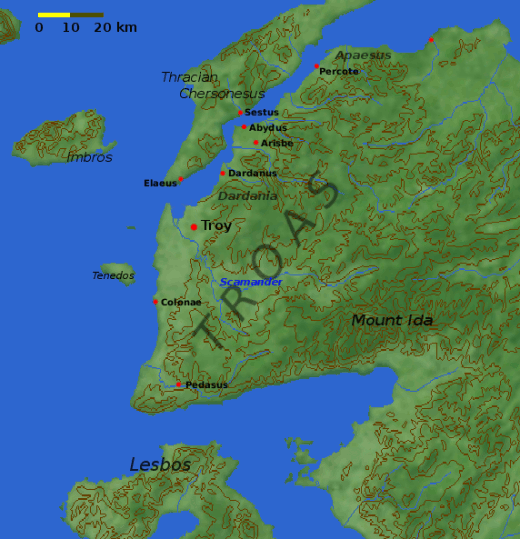
Bryce also reports that archeological surveys conducted by John Bintliff in
the 1970s show that a powerful kingdom that held sway over northwestern Anatolia
was based at Wilusa (Troy).
The kings of
Pergamum
(now
Bergama
) later ceded the territory of the Troad
to the
Roman Republic
. Under the
Empire
, the territory of the Troad became part
of the
province of Asia
; under the later
Byzantine Empire
, it was included in the
thema
of the Aegean Islands. Following its
conquest by the
Ottoman Empire
, the Troad formed part of the
sanjak
of
Biga
.
In the New Testament
Paul
visited Troas. He also refers to Troas
when he asks his fellow worker
Timothy
out of
Ephesus
, to get his coat there.[3]
This was a journey of about 500 kilometres (310 mi). Paul was accompanied by
Luke
.

Pegasus, as the horse of Muses, was put on the roof of
Poznań
Opera House
(Max
Littmann, 1910)
Pegasus (Greek
Πήγασος/Pegasos, Latin n Pegasus) is one of the best known fantastical
creatures in
Greek mythology
. He is a winged divine horse,
usually white in color. He was sired by
Poseidon
, in his role as horse-god, and foaled
by the Gorgon
Medusa
. He was the brother of
Chrysaor
, born at a single birthing when
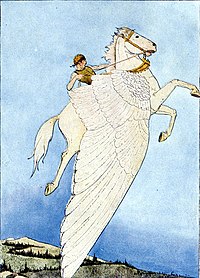
his
mother was decapitated by Perseus. Greco-Roman poets write about his ascent to
heaven after his birth and his obeisance to
Zeus, king of the gods, who instructed him to bring lightning and
thunder from Olympus. Friend of the Muses, Pegasus is the creator of
Hippocrene
, the fountain on
Mt. Helicon
. He was captured by the Greek hero
Bellerophon
near the fountain Peirene with the
help of Athena and Poseidon. Pegasus allows the hero to ride him to defeat a
monster, the Chimera, before realizing many other exploits. His rider, however,
falls off his back trying to reach Mount Olympus. Zeus transformed him into the
constellation
Pegasus
and placed him in the sky.
Hypotheses have been proposed regarding its relationship with the
Muses
, the gods
Athena
,
Poseidon
,
Zeus, Apollo
, and the hero
Perseus
.
The symbolism of Pegasus varies with time. Symbol of wisdom and especially of
fame from the Middle Ages until the Renaissance, he became one symbol of the
poetry and the creator of sources in which the poets come to draw inspiration,
particularly in the 19th century. Pegasus is the subject of a very rich
iconography, especially through the ancient Greek pottery and paintings and
sculptures of the Renaissance. Personification of the water, solar myth, or
shaman mount, Carl Jung and his followers have seen in Pegasus a profound
symbolic esoteric in relation to the spiritual energy that allows to access to
the realm of the gods on Mount Olympus.
In the 20th and 21st century, he appeared in movies, in fantasy, in video
games and in role play, where by extension, the term Pegasus is often used to
refer to any winged horse.
Miletus (mī lē’ təs) (Ancient
Greek: Μίλητος, literally
transliterated
Milētos,
Latin
Miletus) was an
ancient
city on the western coast of
Anatolia
(in what is now
Aydin Province
, Turkey
), near the mouth of the
Maeander River
in ancient
Caria
. Evidence
of first settlement at the site has been made inaccessible by the rise of sea
level and deposition of sediments from the Maeander. The first available
evidence is of the
Neolithic
.
In the early and middle
Bronze age
the settlement came under
Minoan
influence. Legend has it that an influx of Cretans occurred
displacing the indigenous
Leleges
. The
site was renamed Miletus after a place in
Crete
.
The Late Bronze Age, 13th century BCE, saw the arrival of
Luwian language
speakers from south central Anatolia calling themselves the
Carians
.
Later in that century the first Greeks arrived, calling themselves
Achaeans
.
The city at that time rebelled against the
Hittite Empire
. After the fall of that empire the city was destroyed in the
12th century BCE and starting about 1000 BCE was resettled extensively by the
Ionian Greeks
.
Legend offers an Ionian foundation event sponsored by a founder named Neleus
from the
Peloponnesus
.
The
Greek Dark Ages
were a time of Ionian settlement and consolidation in an
alliance called the
Ionian League
. The
Archaic Period
of Greece began with a sudden and brilliant flash of art and
philosophy on the coast of
Anatolia
.
In the
6th Century BC
, Miletus was the site of origin of the Greek philosophical
(and scientific) tradition, when
Thales
,
followed by
Anaximander
and
Anaximines
(known collectively, to modern scholars, as the
Milesian School
) began to speculate about the material constitution of the
world, and to propose speculative naturalistic (as opposed to traditional,
supernatural) explanations for various natural phenomena.
//
Geography
The ruins lies about 5 kilometres (3.1 mi) north of
Akkoy
.
The city also once possessed a
harbor
, before
it was clogged by
alluvium
brought by the
Meander
River. There is a Great Harbour Monument where it is believed that
Paul stopped by and sat on its steps, on the way back to Jerusalem by boat. He
may have met the Ephesian Elders and then headed out to the beach to bid them
farewell, recorded in the book of Acts.
Geology
During the
Pleistocene
epoch the Miletus region was submerged in the
Aegean Sea
.
It subsequently emerged slowly, the sea reaching a low level of about 130 meters
(430 ft) below present level at about 18,000 BP.
The site of Miletus was part of the mainland.
A gradual rise brought a level of about 1.75 meters (5 ft 9 in) below present
at about 5500 BP, creating several
karst
block islands of limestone, the location of the first settlements at
Miletus. At about 1500 BCE the karst shifted due to small crustal movements and
the islands consolidated into a peninsula. Since then the sea has risen 1.75 m
but the peninsula has been surrounded by sediment from the
Maeander
river and is now land-locked. Sedimentation of the harbor began at
about 1000 BCE, and by 300 CE Lake Bafa had been created.[1]
History
Neolithic
The earliest available archaeological evidence indicates that the islands on
which Miletus was originally placed were inhabited by a
Neolithic
population in the 2nd half of the 4th millennium BCE (3500–3000 BCE).[2]
Pollen in core samples from Lake Bafa in the
Latmus
region inland of Miletus suggests that a lightly-grazed climax forest prevailed
in the
Maeander
valley, otherwise untenanted. Sparse Neolithic settlements were
made at springs, numerous and sometimes geothermal in this karst, rift valley
topography. The islands offshore were settled perhaps for their strategic
significance at the mouth of the Maeander, a route inland protected by
escarpments. The grazers in the valley may have belonged to them, but the
location looked to the sea.
Bronze
Age
Recorded history at Miletus begins with the records of the
Hittite Empire
in the Late Bronze Age. The prehistoric archaeology of the
Early and Middle Bronze Age portrays a city heavily influenced by society and
events elsewhere in the Aegean, rather than inland.
Cretan
period
Beginning at about 1900 BCE artifacts of the
Minoan civilization
acquired by trade arrived at Miletus.[2]
For some centuries the location received a strong impulse from that
civilization, an archaeological fact that tends to support but not necessarily
confirm the founding legend—that is, a population influx, from
Crete
. According
to Strabo
:[3]
Ephorus says: Miletus was first founded and fortified above the sea by
Cretans, where the Miletus of olden times is now situated, being settled by
Sarpedon, who brought colonists from the Cretan Miletus and named the city
after that Miletus, the place formerly being in possession of the
Leleges
.
The legends recounted as history by the ancient historians and geographers
are perhaps the strongest; the late mythographers have nothing historically
significant to relate.[4]
Luwian
and Greek period
Miletus is first mentioned in the
Hittite
Annals of Mursili II
as Millawanda. In ca. 1320 BC, Millawanda supported the
rebellion of Uhha-Ziti
of Arzawa
. Mursili ordered his generals
Mala-Ziti
and
Gulla
to raid Millawanda, and they proceeded to burn parts of it (damage
from LHIIIA:2 has been found on-site: Christopher Mee, Anatolia and the
Aegean in the Late Bronze Age, p. 142). In addition the town was fortified
according to a Hittite plan (ibid, p. 139).
Millawanda is then mentioned in the “Tawagalawa
letter“, part of a series including the
Manapa-Tarhunta letter
and the
Milawata letter
, all of which are less securely dated. The Tawagalawa letter
notes that Milawata had a governor,
Atpa
, who was under the jurisdiction of “Ahhiyawa” (a growing state probably
in
LHIIIB
Mycenaean Greece
); and that the town of
Atriya
was under Milesian jurisdiction. The Manapa-Tarhunta letter also
mentions Atpa. Together the two letters tell that the adventurer
Piyama-Radu
had humiliated Manapa-Tarhunta before Atpa (in addition to other
misadventures); a Hittite king then chased Piyama-Radu into Millawanda and, in
the Tawagalawa letter, requested Piyama-Radu’s extradition to
Hatti
.
The Milawata letter mentions a joint expedition by the Hittite king and a
Luwiyan
vassal (probably
Kupanta-Kurunta
of Mira) against Milawata (apparently its new name), and
notes that Milawata (and Atriya) were now under Hittite control.
Homer
records
that during the time of the
Trojan War
,
it was a
Carian
city (Iliad,
book II).
In the last stage of LHIIIB, the citadel of
Pylos
counted
among its female slaves “Mil[w]atiai”, women from Miletus.
During the collapse of Bronze Age civilisation, Miletus was burnt again,
presumably by the
Sea
Peoples
.
Dark
Age
Mythographers told that
Neleus
son of
Codrus of Athens had come to Miletus after the return of the Heraclids (so,
during the Greek Dark Age). The Ionians killed the men of Miletus and married
their widows.
Archaic
period

Map of Miletus and Other Cities within the Lydian Empire
The city of Miletus became one of the
twelve
Ionian
cities of
Asia Minor
.
Miletus was one of the cities involved in the
Lelantine War
of the 8th century
BCE
.
Miletus was an important center of philosophy and science, producing such men
as Thales
,
Anaximander
and
Anaximenes
.
By the 6th century BCE, Miletus had earned a maritime empire but brushed up
against powerful Lydia
at home.
When
Cyrus
of Persia defeated
Croesus
of
Lydia, Miletus fell under
Persian
rule. In 502 BC, the
Ionian Revolt
began in
Naxos
;
and when Miletus’s tyrant
Aristagoras
failed to recapture the island, Aristagoras joined the revolt as
its leader. Persia quashed this rebellion and punished Miletus in such a fashion
that the whole of Greece mourned it. A year afterward,
Phrynicus
produced the tragedy The Capture of Miletus in Athens. The
Athenians fined him for reminding them of their loss.
Classical
period
Its gridlike layout, planned by
Hippodamos
, became the basic layout for
Roman
cities.
In 479 BC, the Greeks decisively defeated the Persians at the Greek mainland,
and Miletus was freed of Persian rule. During this time several other cities
were formed by
Milesian
settlers, spanning across what is now Turkey and even as far as
Crimea
.
The eponymous founder of the bawdy Miletian school of literature
Aristides of Miletus
taught here.
Alexandrian
period
In 334 BC, the city was liberated from Persian rule by
Alexander the Great
.
Roman
period
The
New
Testament
mentions Miletus as the site where the Apostle
Paul
in 57 CE met with the elders of the
church
of Ephesus
near the close of his Third Missionary Journey, as recorded in
Acts of the Apostles
(Acts 20:15–38). It is believed that Paul stopped by
Great Harbour Monument and sat on its steps. He may have met the Ephesian elders
there and then bid them farewell on the nearby beach. Miletus is also the city
where Paul left
Trophimus
,
one of his travelling companions, to recover from an illness (2
Timothy 4:20). Because this cannot be the same visit as Acts 20 (in which
Trophimus accompanied Paul all the way to Jerusalem, according to Acts 21:29),
Paul must have made at least one additional visit to Miletus, perhaps as late as
65 or 66 CE. Paul’s previous successful three-year ministry in nearby
Ephesus
resulted in the evangelization of the entire province of Asia (see Acts 19:10,
20;
1 Corinthians
16:9). It is safe to assume that at least by the time of the
apostle’s second visit to Miletus, a fledgling Christian community was
established in Miletus. (The rendering of the
King James Version
of
Malta
as “Melita”
in Acts 28:1 has created confusion between Malta and Miletus among some readers
of the Bible.)
Byzantine
period
During the
Byzantine
age Miletus became a residence for archbishops. The small
Byzantine castle called Castro Palation located on the hill beside the city, was
built at this time.
Turkish
rule
Seljuk Turks
conquered the city in the 14th century A.D. and used Miletus as
a port to trade with
Venice
.
Finally,
Ottomans
utilized the city as a harbour during their rule in
Anatolia
.
As the harbour became silted up, the city was abandoned. Today the ruins of city
lie some 10 kilometres from the sea.
Archaeological
excavations
The first excavations in Miletus were conducted by the French archaeologist
Olivier Rayet in 1873, followed by the German archaeologist
Theodor Wiegand
. Excavations, however, were interrupted several times by
wars and various other events. Today, excavations are organized by the
Ruhr University
of
Bochum
,
Germany
.
One remarkable artifact recovered from the city during the first excavations
of the 19th century, the
Market Gate of Miletus
, was transported piece by piece to
Germany
and
reassembled. It is currently exhibited at the
Pergamon museum
in
Berlin
. The
main collection of artifacts resides in the Miletus Museum in
Didim
,
Aydın
, serving
since 1973.
Colonies
of Miletus
Pliny the Elder
mentions 90 colonies founded by Miletus in his
Natural History
(5.112).
- Apolonia
- Odessos
-
Tomis
-
Histria
- Tyras
-
Olbia
-
Panticapaeum
- Theodosia
- Tanais
- Phanagoria
-
Pityus
-
Dioscurias
-
Phasis
-
Trapezunt
-
Amisos
-
Sinope
Notable
people
- Thales
(c. 624 BC–c. 546 BC)
Pre-Socratic
philosopher
- Anaximander
(c. 610 BC–c. 546 BC) Pre-Socratic philosopher
-
Anaximenes
(c. 585 BC–c. 525 BC) Pre-Socratic philosopher
-
Hippodamus of Miletus
(c. 498—408 BC) urban planner
- Aspasia
(c. 470–400 BC) courtesan , and mistress of
Pericles
,
was born here
-
Aristides of Miletus
, writer
-
Hecataeus of Miletus
, historian
-
Hesychius
(6th century) Greek chronicler and biographer
-
Isidore
(4th–5th century) Greek architect
- Aristagoras
(5th–6th century) Tyrant of Miletus
- Leucippus
(first half of 5th century BC) Philosopher and originator of
Atomism (his association with Miletus is traditional, but disputed)
|










